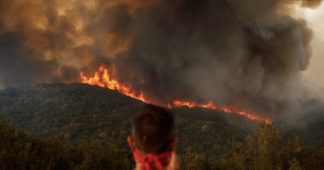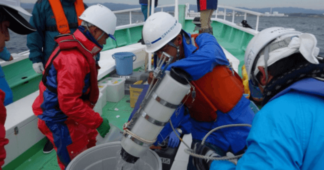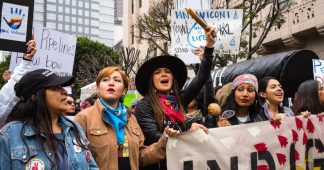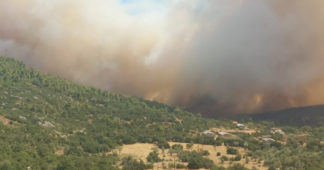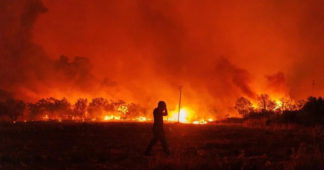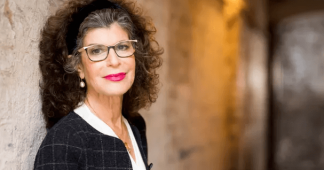“Justice is returning control of public resources like land and water to the people,” wrote one activist. “For too long the strings of Maui and thousands of communities like it have been pulled by forces indifferent to their soul.”
By Jessica Corbett
As Maui County faces a daunting recovery from the deadliest U.S. wildfire in over a century—with at least 115 confirmed deaths as of Tuesday, around 1,000 people still unaccounted for, and a rebuild expected to cost billions of dollars—fears and fights over land and water are highlighting the long history of colonialism and exploitation in the Hawaiian Islands.
“It’s disaster capitalism at its finest,” Hokuao Pellegrino, a seventh-generation Native Hawaiian farmer, educator, and president of the nonprofit Hui o Nā Wai ‘Ehā, toldCNN in a Monday segment about Maui’s current water battles.
Disaster capitalism, as journalist Naomi Klein explained in her 2007 book The Shock Doctrine, is “orchestrated raids on the public sphere in the wake of catastrophic events, combined with the treatment of disasters as exciting market opportunities.”
Fire spread by hurricane winds earlier this month leveled Lahaina, a Maui tourist destination that was previously the capital of the Hawaiian Kingdom, before an 1893 coup led by American expatriates and sugar planters. The United States formally annexed the islands in 1898. Hawaii became a U.S. territory in 1900 and the 50th state in 1959.
“Disaster capitalism has taken many forms in different contexts,” Klein wrote last week in a Guardian column with Kapua’ala Sproat, a University of Hawaii at Manoa law professor and director of the Ka Huli Ao Center for Excellence in Native Hawaiian Law.
“It’s always a little different, which is why some Native Hawaiians have taken to calling their unique version by a slightly different term: plantation disaster capitalism,” the pair continued. “It’s a name that speaks to contemporary forms of neocolonialism and climate profiteering, like the real estate agents who have been cold-calling Lahaina residents who have lost everything to the fire and prodding them to sell their ancestral lands rather than wait for compensation. But it also places these moves inside the long and ongoing history of settler colonial resource theft and trickery, making clear that while disaster capitalism might have some modern disguises, it’s a very old tactic. A tactic that Native Hawaiians have a great deal of experience resisting.”
As Klein and Sproat detailed:
“For over a century, water across Maui Komohana, the western region of the island, has been extracted to benefit outside interests: first large sugar plantations and, more recently, their corporate successors. The companies—including West Maui Land Co. (WML) and its subsidiaries, as well as Kaanapali Land Management and Maui Land & Pineapple Inc.—have devoured the island’s natural resources to develop McMansions, colonial-style subdivisions, luxury resorts, and golf courses where cane and pineapple once grew.
This historical and modern plantation economy has taken a tremendous toll on water in particular, draining Indigenous ecologies of their natural moisture. Lahaina, once known as the Venice of the Pacific, has been transformed into a parched desert, which is part of what has made it so vulnerable to fire.”
A few days after flames tore through Lahaina, Hawaiian state Attorney General Anne Lopez announced a probe into the formal response. Her sweeping investigation includes a five-hour delay in the state Commission on Water Resource Management (CWRM)—which is responsible for how much water flows through streams—approving WML’s request to fill its private reservoirs that are not connected to local hydrants but the company was willing to make available to firefighters.
The delay was reportedly the result of unsuccessful attempts to reach a farmer of taro—or kalo, a root vegetable sacred to Native Hawaiians—affected by the diversion. Activists and officials have pointed out that wind would have prevented helicopter crews from reaching the WML reservoirs for firefighting. According to the Honolulu Civil Beat, “The company suffered no significant property damage in the fires.”
A water official involved with the delay, Kaleo Manuel, was then reassigned to another Hawaii Department of Land and Natural Resources division—though the DLNR said in a statement last week that the shift was part of an effort “to focus on the necessary work to assist the people of Maui recover from the devastation of wildfires” and “does not suggest that First Deputy Manuel did anything wrong.”
In a lawsuit filed Monday, Maui residents Kekai Keahi and Jennifer Kamaho’i Mather argue that the redeployment was illegal, and ask a Hawaii court to void the decision and affirm that any such move must be made in an open meeting to allow public testimony.
Hawaii Public Radioreported Tuesday that while decision has also “prompted serious concerns” from CWRM members, the state attorney general’s office claims the case is “wholly without merit” and plans to file a motion to dismiss it.
Lawsuit filed by Lahaina residents against DLNR Chair for unlawful removal of Deputy Kaleo Manuel
It is terrible that these families who are suffering from impacts of fire are also battling a government that is trying to return water management to the oligarch plantations pic.twitter.com/oM4t0gUzxx
— Dr. Kamanamaikalani Beamer (@kamanabeamer) August 22, 2023
“One thing that people need to understand especially those from far away is that there’s been a great deal of water conflict on Maui for many years,” Hawaii Gov. Josh Green said during a press briefing last week. “It’s important that we’re honest about this. People have been fighting against the release of water to fight fires. I’ll leave that to you to explore.”
The Democratic governor has faced criticism for the comments and for suspending the “state water code, to the extent necessary to respond to the emergency,” through his recent proclamations relating to wildfires.
As the Civil Beatreported:
“No one’s trying to oppose the use of water to fight fires,” said Isaac Moriwake, an attorney with Earthjustice. “That was unfair for the governor to go there.”
The real issue, Moriwake said, is that West Maui Land Co. is trying to use the fire as an excuse to gain control over the region’s water supply.
Moriwake points out that Hawaii Board of Land and Natural Resources Chair Dawn Chang has agreed to amend—temporarily—several water regulations, at West Maui Land Co.’s request, pursuant to an emergency declaration related to the fire issued by Green. That included a provision allowing companies like West Maui Land to fill its reservoirs when fire was reported in the area.
“They should stop trying to use this tragedy for cheap advantage,” Moriwake said.
Kamanamaikalani Beamer, a former member of the CWRM, also challenged Green’s claims about community members fighting against the release of water for firefighting, tellingThe Washington Post that “in my eight years on the water commission, I never heard, in a single hearing, that testimony from anyone in the community.”
Lahaina’s Native Hawaiian community “has fought for literally generations to seek justice and balance for the streams and the community and other usages,” added Beamer, a professor at the University of Hawaii at Manoa’s Center for Hawaiian Studies.
According toThe New York Times:
“Wayne Tanaka, director of the Sierra Club of Hawaii, said conservationists had supported the use of water for fire reserves. But he said he worried that water companies and large landowners use fire protection as an excuse to hoard water for commercial purposes.
“No one has opposed the need to reserve water for firefighting, but we want to know how much they actually use for that purpose,” Mr. Tanaka said.
Sproat made similar remarks in an appearance on Democracy Now! last week after her column with Klein was published.
“Plantation disaster capitalism, I think, is, unfortunately, the perfect term for what’s going on in Maui Komohana, or in West Maui, right now,” Sproat said. “The plantations, the large landed interests that have had control over not just the land, but really much of Hawaii’s and Maui Komohana’s resources for the last several centuries, are using this opportunity, are using this time of tremendous trauma for the people of Maui, to swoop in and to get past the law, basically.”
“They’re using the emergency proclamation that the governor put into place the day after the fires to, you know, ravage Lahaina, and they’re using this as an opportunity to try to get their way, especially with respect to water resources, something they could not achieve when the law and Hawaii’s water code, in particular, were in place,” she explained.
During a Thursday interview with the Civil Beat, Green “defended his position that government, developers, and environmental and cultural activists need to work together to resolve issues,” but also insisted that Lahaina’s rebuild “will be done with direct input from fire survivors, the island, and its mayor,” and “new construction will be primarily to house locals and not to favor large developers.”
A coalition of community members gathered at Maui’s Wahikuli Beach Park for a Friday press conference about rebuilding. Keahi—one of the residents behind the suit over Manuel’s redeployment—said that “we don’t want to hear the governor’s office saying that we have a plan for Lahaina because none of us ever got to speak to the governor.”
Reporting from the event, Hawaii Public Radioexplained that Nā ‘Ohana O Lele—or the Families of Lele, in honor of Lahaina’s ancient name—has three demands for Green: “One is to allow the community time to heal before rebuilding. Two is to let Lahaina lead the planning process. And three is to amend the emergency proclamation to ensure Hawaii’s open meeting regulation or ‘Sunshine Law’ remains in full force.”
"Kekai Keahi said the Lāhainā you see today is the outcome of more than 100 years of the community being dominated by outsider and commercial interests."
Lāhainā group demands time to heal and a voice in rebuilding @wearehpr #HInews #MauiFires #MauiStronghttps://t.co/RMpHRCb72Q
— Nikos Leverenz (@nikosleverenz) August 21, 2023
Noting the group’s demands, Kaniela Ing, a seventh-generation Native Hawaiian and national director of Green New Deal Network, wrote Monday for The Nation, “The vision is clear: The restoration of Lahaina should be by the community, for the community.”
President Joe Biden and First Lady Jill Biden traveled to Maui on Monday to tour the destruction and meet first responders and survivors. In a pair of speeches, the president claimed that “we’re going to rebuild the way the people of Maui want to build.”
“It’s time to rebuild this community the way you want it built—the way you want it—so it’s still a community, not a group of beautiful homes, but a community,” Biden declared at the Lahaina Civic Center, provoking applause from residents impacted by fires.
Still, Hawaiians stress that such words from government officials are not enough—action is also required. Ing wrote Monday that “political and legislative fights lie ahead to ensure that rebuilding efforts steer clear of the pitfalls of external influences, and that resources are channeled to foster local resilience and empowerment.”
“True justice doesn’t lie merely in acknowledging the climate crisis,” he argued. “Justice is returning control of public resources like land and water to the people. It’s about recognizing that for too long the strings of Maui and thousands of communities like it have been pulled by forces indifferent to their soul. It’s acknowledging that survivors aren’t just figures in a news report but the heartbeats of a resilient community that demands its rightful place in shaping its future.”
We remind our readers that publication of articles on our site does not mean that we agree with what is written. Our policy is to publish anything which we consider of interest, so as to assist our readers in forming their opinions. Sometimes we even publish articles with which we totally disagree, since we believe it is important for our readers to be informed on as wide a spectrum of views as possible.
